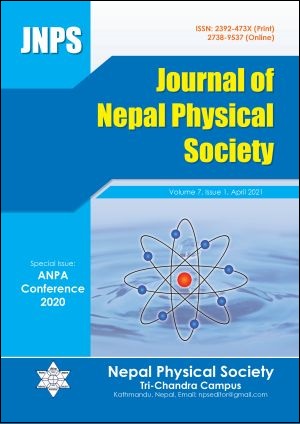Ionospheric Response over Nepal during the 26 December 2019 Solar Eclipse
DOI:
https://doi.org/10.3126/jnphyssoc.v7i1.36970Keywords:
Solar Eclipse, Total Electron Content, GPS, IonosphereAbstract
On 26th December 2019, during morning hours, an annular solar eclipse having a magnitude of 0.96 with a 118 km wide antumbra occurred and lasted for 3 minutes and 40 seconds at the point of maximum eclipse. The partial eclipse was visible in most of Asia, parts of North/East Africa, and North/West Australia. In the context of Nepal, only the partial eclipse was visible from ~ 8:34 LT (02:51 UT) and ended at ~ 11:40 LT (05:55 UT). It was 2 hours 47 mins and 54 secs long with the maximum visible eclipse time at ~ 10:01 LT (04:16 UT). Our study is based on Global Navigation Satellite System (GNSS) measurements from a widely distributed Global Positioning System (GPS) network over different places of Nepal on the day of the eclipse, a day before, and a day after the eclipse. We investigated the ionospheric behavior through the changes in Total Electron Content (TEC) during the partial eclipse by using the data archived at the five different GPS stations of Nepal. The result reveals that there is significant depletion of TEC, in some cases greater than 20% compared to other normal days. Observing the values of TEC before, during, and after the event, our study showed an apparent variation during the time of the eclipse, which agrees with previous studies on ionospheric responses to the eclipse as well as theoretical assumptions.
Downloads
Downloads
Published
How to Cite
Issue
Section
License
All right reserved. No part of this Journal may be reproduced in any form or by any electronic or mechanical means, including information storage and retrieval system, without permission in writing from the publisher, except by a reviewer who may quote brief passage in a review. The views and interpretation in this journal are those of author(s) and they are not attributable to the NPS.




